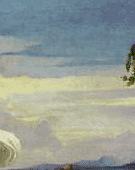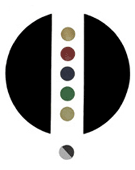Hyperpaintings: Site Analysis
I have called this series of net.art pieces ‘Hyperpaintings’. They are digital reproductions of paintings that have been hyperlinked, using image maps, to a variety of content on the Internet related to the work.
Each piece is different in the way it approaches this basic premise. My aim has been to deconstruct and reinterpret existing works of art using the Internet.
192 One Dollar Bills.net
The image used for 192 One Dollar Bills.net is a screenprint by the artist Andy Warhol titled ‘192 One Dollar Bills’.
An interior designer and art dealer, Muriel Latow, suggested early on that Andy should paint what he liked most in the world, and that was money. 'Oh gee,' Andy is said to have replied, 'that really is a great idea.'(1)
Each dollar bill on is turned into a link, taking the user to a remote web-page. Each page ...
Full Description
Hyperpaintings: Site Analysis
I have called this series of net.art pieces ‘Hyperpaintings’. They are digital reproductions of paintings that have been hyperlinked, using image maps, to a variety of content on the Internet related to the work.
Each piece is different in the way it approaches this basic premise. My aim has been to deconstruct and reinterpret existing works of art using the Internet.
192 One Dollar Bills.net
The image used for 192 One Dollar Bills.net is a screenprint by the artist Andy Warhol titled ‘192 One Dollar Bills’.
An interior designer and art dealer, Muriel Latow, suggested early on that Andy should paint what he liked most in the world, and that was money. 'Oh gee,' Andy is said to have replied, 'that really is a great idea.'(1)
Each dollar bill on is turned into a link, taking the user to a remote web-page. Each page has something on offer for a dollar. There are however, a handful of exceptions to this, there are items for under a dollar and an offer to buy one dollar for 50 bucks!
The range of items on sale for $1 linked to is extremely varied from U.S. Stars and stripes flags (2 for a buck) to toys for your pet bird and money conversion tables that will tell you how many euros can you buy for a dollar.
The result is a subversion of the notion ‘art object as commodity’, turning the art object into a means of acquiring commodities.
The work utilises the hyperlink, a fundamental web technology that enables people to interact with the painting, exploring the work and what it has to offer. It is a simple piece in terms of the types of action included, but holds it’s main interest in the content you link to on the remote sites.
The piece can be strangely addictive, you quickly realize that the dollar bills link to items for sale and that each is unique. You become curious to know what else is ‘hidden’ behind the bills. The work taps into one of our favourite pastimes, shopping, an activity for which people will spend hours online. By utilising a wider sphere of interest i.e. shopping as opposed to a single subject it may increase the average viewing time for this piece of work. While it has less depth in terms of information provided than other works in the series it retains something of the quick gratification that attracts people to online shopping.
As the bills are linked entirely to remote content the piece will require a fairly high level of maintenance. It is hoped, in time, that more stable links will be found, i.e. $1 areas in shops or bargain/discount corners, lessening the need for checking and repairing.
Nothing
‘Nothing’ as the title would suggest, offers you just that, nothing. On linking to it from the homepage you are confronted with a blank screen. As the screen is programmed to be blank the browser window will display the user’s own personalised colour or the default.
After ‘Nothing’ loads the user will hopefully try to make something happen by clicking the window, a common reaction when things appear to not work.
The user then discovers the apparent nothing has been divided up into hyperlinked areas, each link sending the user to a unique piece of content on the theme of nothing. The content in ‘Nothing’ is more diverse than other works in the series. The links do not follow a format i.e. all remote content, selling sites or colour but have a variety of content, both remote and self constructed.
The linked aspects of the website I have constructed are:
· A mailto: link to noone@nowhere.co.uk inviting you to send nothing to no-one at an address that does not exist.
· A web-page offering you the opportunity to ‘upload files from your computer to ‘Nothing’ upon submission you are informed that ‘Your file has been uploaded to nowhere.’
· A page where the user is invited to contribute to nothing. A text box which has the text and Background colour set to white gives the impression of writing nothing. Again on submission you are politely informed that it has gone nowhere.
Minimalist art is an obvious reference for this piece. This is reflected in links describing the movement itself and links to images of minimalist paintings
‘Nothing’ is a successful piece as long as the user is able to begin to interact with the work. However, even if they decide to simply click back on their browser assuming there is nothing to see the aim of giving them nothing has been achieved!
‘Nothing’ has a good variety of interesting links to encourage the viewer to spend longer with the work. It also has interactive content allowing the user to interact more deeply with the work. While there are fewer remote content sites the complexity of the image map makes it harder to maintain.
Bacchus After Ariadne, After Titian
‘Bacchus and Ariadne’ by Titian has always been a favourite painting of mine both for it’s colour and the narrative. I have attempted in ‘Bacchus after Ariadne, after Titian’ to deconstruct the background to the myth described in the painting and allude to the events surrounding the painting’s life.
Bacchus is the god of wine and revelry, he has just happened upon the beautiful Ariadne, abandoned on the shore by her lover Theseus after being ordered to do so by the goddess Athena. Ariadne had helped Theseus to escape the Minotour’s labyrinth using thread to find his way out. Bacchus sees her, falls in love and it is this moment that Titian depicts in the painting.
This is the most ambitious Hyperpainting in the series utilising the widest range of techniques and with the largest range and depth of content.
The page opens with an alert asking the user to ‘insert their favourite party CD and have a drink’ coinciding with the CD tray opening. This will only work in Microsoft Windows with both IE and Windows media Player installed but the alert will always appear.
There are two pieces of Javascript, which make the browser shake and lurch. When Bacchus’ leg is clicked the browser shakes, enhancing the instability of his pose and simulating inebriated vision. Silneus, the old man on a donkey in the top right, makes the window lurch when clicked. He represents that particular aspect of wine drinking, excess. To reflect this when the lurching finishes it turns to shaking as a website for a hangover cure opens.
Other Links include a simple maze game I found based on the story of Theseus and the Minotour, this appears when Theseus’s boat is clicked, just to the left of Ariadnes face. The National Gallery, which houses the painting, has an online shop which is linked to from the clouds where you can buy bags and umbrellas which have images of the sky on them. Links to Dating sites are used in the space between Bacchus and Ariadne symbolizing their love. The snakes wrapped around the figure in the foreground hiss when clicked. Other figures, fauna and flora are linked to other relevant sites.
The variety of links and techniques in this piece make it the most complicated piece both in the construction and in user interaction. The success of ‘Bacchus after Ariadne, after Titain’ will depend on the amount of time spent exploring the links. Unlike ‘$192.net’ the rationale is more complex especially if the user has no knowledge of the characters and events depicted. Hopefully through following the links and effects the story will unfold. Fewer links and links to solid websites that rarely change like ‘The National Gallery’ should make maintenance less on this piece than some.
Vertumnus
Sixteenth Century artist Guissepe Archimboldo painted the original ‘Vertumnus’ from 1590-1591. It is both a portrait of Archimboldo’s patron Emperor Rudolph II and a representation of the Roman God Vertumnus. Vertumnus is described as:
The Roman divinity of seasons, changes and ripening of plant life. He is the patron of gardens and fruit trees.(2)
Archimboldo has used fruit, vegetables and flowers to make up the parts of the face. Each fruit, vegetable and flower has been linked to web-pages that give a variety of information on the respective flora. Clicking on the pumpkin reveals the story of pumpkin cam, the cherries link to a recipe for Italian cherry cocktail. Some links like the cheek, a peach, give a history of the plant. Others explain how to grow the plant itself or ideas for recipes, potion etc for when you have grown it.
When Archimboldo painted the original in Milan, Italy it was a time of global travel, which brought new, exotic fruit and vegetables into Europe. The absence of tomatoes in an Italian painting of food may seem odd until you discover that tomatoes were brought in much later from Mexico, not in time for Guisseppe’s painting. An in depth exploration of all the links would give the user a good grounding in the introduction of foods into Italy during the 15th century, as well as some good recipes.
‘Vertumnus’ is a more in depth piece than ‘Le Grande Jatte’ or ‘192 One Dollar Bills.net’ in terms of the amount of information supplied through the links. The user has the choice of skimming the content in the linked page or spending time exploring the subject in more detail.
‘Vertumnus’ uses remote content from a wide variety of sites, some of which will include live, streamed video content during the growing season. This means it will require maintenance to check for broken links.
La Grande Jatte
‘La Grande Jatte’ is an interactive work exploring colour. It is based on the painting ‘A Sunday Afternoon on the Island of La Grande Jatte’ 1884-1886 by Georges Seurat.
Seurat made the painting as an experiment in colour, he believed that painting in dots, known as pointillism or divisionism, would produce a brighter color than painting in strokes.
The term pointilise has also entered the world of computer imaging through the many pointilise filters on image-based software. These transform images, describing them in pointillist style dots.
When viewing pointillist paintings in galleries viewers repeatedly step up to them and away again, testing the technique. Up close, single points of colour can be seen, moving away these melt into a recognisable image.
I have created an electronic version of ‘La Grande Jatte’ that utilises this idea. When you click a section of the image it fades to a page which is the colour of the area that you selected. After a couple of seconds the pages will fade back to ‘La Grande Jatte’. The fade effect only works in Internet Explorer.
In this format ‘La Grande Jatte’ uses Internet protocols and language to allow the viewer to interact with the content. ‘La Grande Jatte’ however, is the only Hyperpainting which could exist offline. It does not rely on remote content and could be presented on a CD Rom.
‘La Grande Jatte’ may have a short viewing time as the piece of work is simple to understand. Users may feel after four or five transitions from original image to single colour that they have explored what the piece has to offer.
(1)http://observer.guardian.co.uk/review/story/0,6903,639878,00.html [Accessed May 19, 2004]. "Vertumnus." Encyclopedia Mythica from Encyclopedia Mythica Online.
(2)http://www.pantheon.org/articles/v/vertumnus.html [Accessed May 19, 2004
Work metadata
- Year Created: 2004
- Submitted to ArtBase: Thursday Sep 16th, 2004
- Original Url: http://zappa.tvu.ac.uk/03youngd
- Permalink: http://zappa.tvu.ac.uk/03youngd
-
Work Credits:
- Dan Young, creator
Take full advantage of the ArtBase by Becoming a Member





